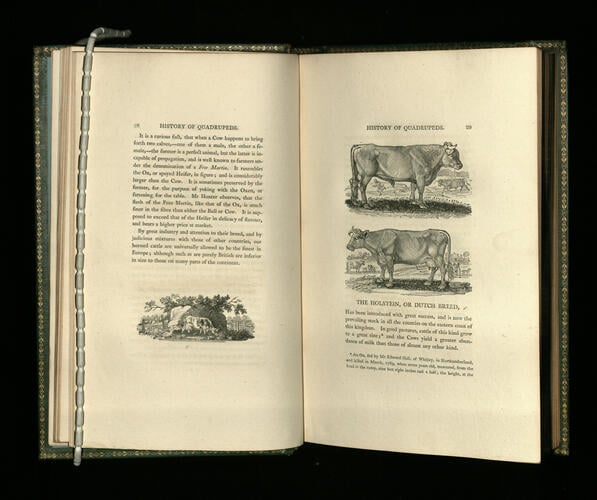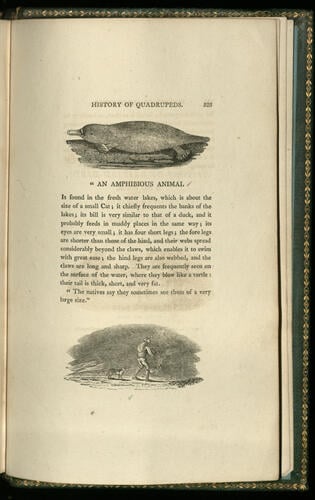-
1 of 253523 objects
A General history of quadrupeds. The fifth edition / the figures engraved on wood by Thomas Bewick. 1807
27.0 x 17.4 x 5.2 cm (book measurement (conservation)) | RCIN 1055619

Thomas Bewick (1753-1828)
A General history of quadrupeds. The fifth edition / the figures engraved on wood by Thomas Bewick 1807

Thomas Bewick (1753-1828)
A General history of quadrupeds. The fifth edition / the figures engraved on wood by Thomas Bewick 1807



-
Thomas Bewick was a Newcastle-based publisher and natural history author. Born at Cherryburn in Northumberland, Bewick was apprenticed to the engraver Ralph Beilby, from whom he learned how to engrave on wood and metal. Beilby preferred the latter, leaving his apprentice to learn the former. The young Bewick showed an immediate aptitude, quickly developing techniques that earned him a medal from the Royal Society of Arts in 1775 for his designs. The innovations popularised by Bewick saw carvings made against the grain of the wood with tools normally reserved for metal engraving. This allowed for much greater detail and subtler shading in the resulting print compared to a traditional woodcut.
Becoming a partner in 1776, the business became recognised for the fine quality of its engravings. In 1790, Bewick and Beilby published their History of Quadrupeds (referred to by Bewick simply as 'Quads'), a natural history of four-legged animals.Bewick began preparing his illustrations for the proposed work in November 1785, beginning with the dromedary and other exotic animals. The text was left to Beilby, who used several natural history authorities, particularly the works of Buffon, John Ray and Thomas Pennant as well as historical sources and anecdotal evidence. The book quickly took on a regional focus, with tales taken from local sources and a number of illustrations being drawn from life during Bewick’s various travels in Northumberland and County Durham, or from specimens owned by friends, acquaintances and local gentry.
For the more unusual animals, Bewick enlisted his brother John, who had recently moved to London, to make his own sketches of wildlife found in the menageries and taxidermy collections in the city. John Bewick also collected sample engravings from print sellers, sending then north for his brother to work up for the cuts.By January 1788, the first publishing proposals were issued, advertising 1,500 copies in the standard demy octavo, with 100 in a larger royal size. While Beilby was enthusiastic in wanting to travel to London to buy paper stock and garner interest in the volume, Bewick was reluctant and instead remained in Newcastle.
Through 1788 and 1789, daily business and commissions caused several delays in the book’s production. These included the commissioning of what would become Bewick’s most significant engraving, the ‘Chillingham Bull’ for Marmaduke Tunstall (1743-90). The print saw Bewick raise the reputation of wood engraving, demonstrating that a hitherto neglected artform could be comparable to copperplates.
When time came for the book to finally be published, the project saw one final snag. Beilby wanted to place himself on the title page as the book’s author, with Bewick listed only as an illustrator. The printer, Solomon Hodgson, soon removed this, recognising Bewick’s input in editing Beilby’s text, primarily regarding domestic livestock.Quadrupeds was immediately successful on its publication. Offering an inexpensive, informative guide to the wonders of the natural world, the book quickly became popular with amateur naturalists. Bewick’s decision not to travel to London also paid off, his engravings being lauded by London society as the discovery of an unknown provincial talent. This saw further demand and two more editions were printed before 1800. Bewick also became the recipient of thousands of letters from interested amateurs and quickly became one of the leading lights of late eighteenth-century natural history.
In 1800, a fourth edition of Quadrupeds was published with additional entries on new livestock breeds and two unusual Australian animals (a wombat and a platypus) sent to Newcastle in 1798 by John Hunter, the governor of New South Wales. Bewick drew the pair and was one of the first naturalists to print an illustration. To further enhance the status of the new edition, Bewick included Linnaean binomial names for each of the animals included, as well as issuing a limited number of volumes in the prestigious imperial size.
Hodgson died shortly after the publication of the fourth edition and following a rift between Bewick and Beilby over the authorship of their first volume on British birds, Land Birds (1797), critics began to proclaim that Quadrupeds was unlikely to see another reprint.
Hodgson’s share in the work passed to his wife Sarah. She was a shrewd businesswoman and in 1802 declared that the book had been her husband’s idea and that she planned to issue a reprint. This angered Bewick and in 1804, after Beilby sold his share to his former partner, he sought legal advice over its copyright. A series of angry letters published in the Monthly Magazine saw the conflict burst into the open, with Sarah Hodgson revoking the Bewick family access to her family pew in the local church.
Despite the tension, Bewick agreed with Hodgson that the book needed a fifth edition and proposed to sell her his share. She refused (having already opened negotiations to sell her share to the London publishers Longmans) and Bewick went instead to the printer Edward Walker for his fifth edition. However, Hodgson’s name remained on the title page.This copy of the fifth edition was acquired by George IV when Prince of Wales for his library at Carlton House.
Primary source: Jenny Uglow, Nature’s Engraver: A Life of Thomas Bewick (London, 2007)
Provenance
Purchased as a set with A History of British Birds (Imperial 8vo, RCINs 1055617-18) by George IV when Prince of Wales from Thomas Payne, 27 June 1808, for £7.17.6 (RA GEO/MAIN/28512)
-
Creator(s)
Acquirer(s)
-
Measurements
27.0 x 17.4 x 5.2 cm (book measurement (conservation))
Alternative title(s)
A General History of Quadrupeds. The figures engraved on wood by Thomas Bewick. The Fifth edition.